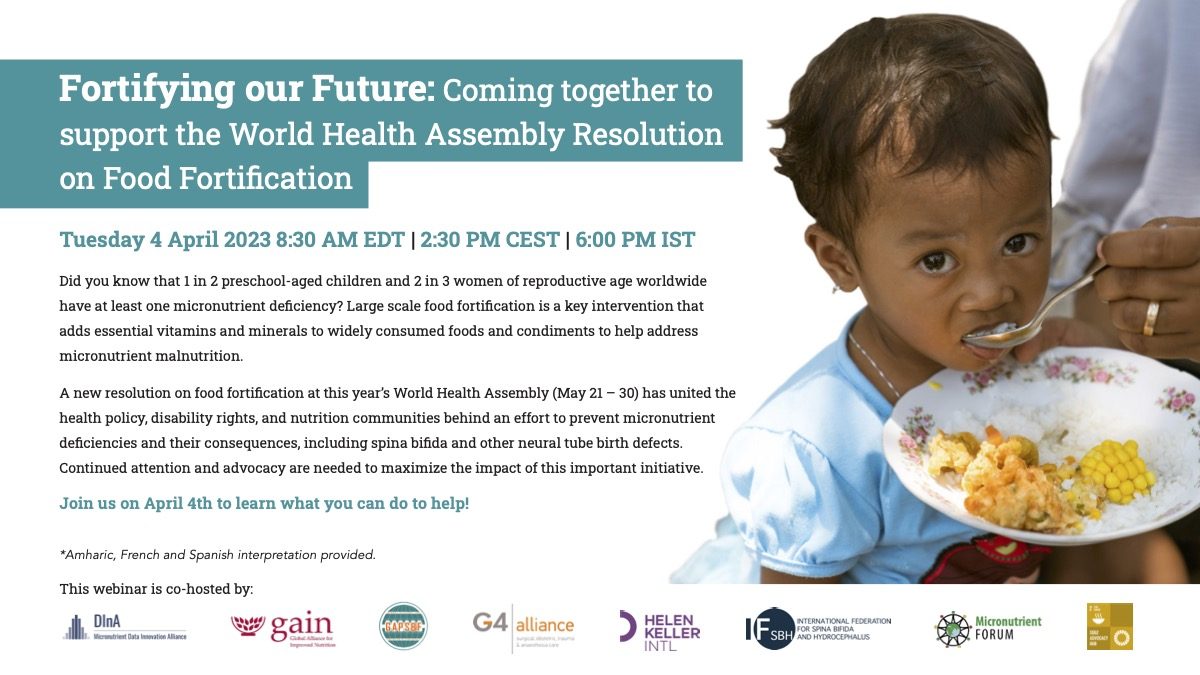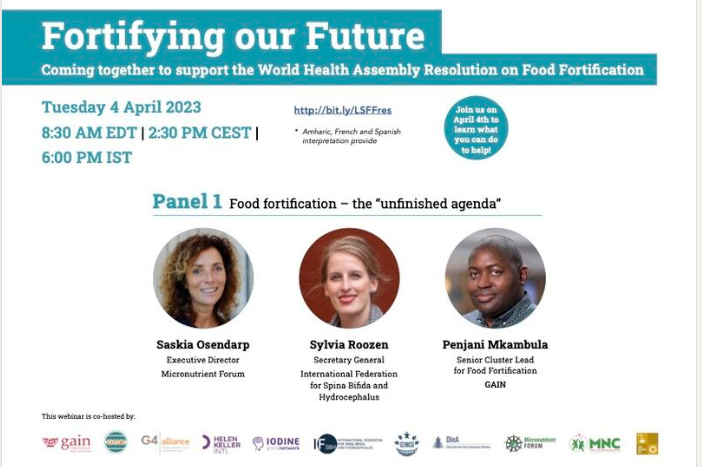Fortifying our Future: Coming together to support the World Health Assembly Resolution on Food Fortification: Key Takeaways

The webinar ‘Fortifying our Future: Coming together to support the World Health Assembly Resolution on Food Fortification’, held on 4 April 2023, was hosted by Global Alliance for Improved Nutrition (GAIN) in collaboration with the International Federation for Spina Bifida and Hydrocephalus, GAPSBi-F, G4 Alliance, Helen Keller Intl, Micronutrient Forum, Mighty Nutrients Coalition, SDG2 Advocacy Hub, Iodine Global Network, iZincG and Micronutrient Data Innovation Alliance. The webinar aimed to bring together a diverse coalition of advocates and stakeholders, such as experts in the fields of disability rights, neurosurgery, micronutrient malnutrition, food fortification, public health, and fortified food production to support the WHA food fortification initiative, as well as, to maximise the impact of the proposed resolution, ‘Accelerating efforts for preventing micronutrient deficiencies and their consequences, including spina bifida, and other neural tube defects, through safe and effective food fortification’.

This event was a 90-minute virtual conference, structured around informal Q&A panels guided by moderator, Shawn Baker – Chief Program Officer, Helen Keller Intl; Vice-Chair, Board of Directors, MNF, and panels of guests including:
- Fadoi Chaouki, Nutrition Policy Officer, Directorate General of International Partnerships, European Commission
- Haymanot Asfaw, Manager, Mintu Investment Group, Former GM, Ethiopian Millers Association
- Inoshi Sharma, Executive Director, FSSAI
- Dr Kemel Ghotme, paediatric neurosurgeon, researcher, and advocate
- Dr Luz Maria De-Regil, Head, Multisectoral Action in Food Systems, WHO
- Maria Juliana Tenorio Quintero, Representative, Government of Colombia
- Dr Ndeye Fatou Ndiaye, Coordinator, Senegalese Committee for Food Fortification
- Dr Papatya Genca, Board Member IFSBH, Turkish Spina Bifida Association
- Penjani Mkambula, Senior Cluster Lead for Food Fortification, GAIN
- Dr Saskia Osendarp, Executive Director, MNF
- Dr Sylvia Roozen, Secretary General, IFSBH
The webinar served as a forum to discuss three core areas of safe and effective food fortification :
- What the proposed WHA resolution on food fortification would accomplish if passed
- Perspectives on the WHA LSFF resolution from government and private sector leaders, including how it can support national progress on food fortification
- The “unfinished agenda” of food fortification, including the global prevalence of micronutrient deficiencies and the role of large-scale food fortification to combat malnutrition and its effects
IF has been a vocal proponent for large scale food fortification with folic acid for decades for reducing the prevalence of Spina Bifida and other Neural Tube Defects and as a part of that advocacy IF Secretary General Dr Sylvia Roozen and IF member from Turkey Papatya Alkan Genca took part in the panel discussion, ‘The “unfinished agenda” of food fortification, including the global prevalence of micronutrient deficiencies and the role of large-scale food fortification to combat malnutrition and its effects’.

The panel discussion was opened by Dr. Saskia Osendarp (Executive Director, Micronutrient Forum) who emphasised the prevalence of micronutrient deficiencies, which is far higher than expected and has long-term effects on children’s health and development, particularly the brain, which can lead to poor school performance when attending school and, later in life can lead to lower adult productivity. Penjani Mkambula (Senior Cluster Lead for Food Fortification, GAIN) responded to the query regarding the role of widespread food fortification in addressing micronutrient deficiencies and what needs to be done to make this solution and consumption of these fortified foods possible, by outlining why food fortification should be implemented as part of the solutions package. He pointed out that food fortification is essentially a very simple intervention about adding vitamins and minerals during processing which can help many people in both high-income and low-income countries by utilising foods that are currently consumed on a daily basis in the existing supply chains.
Dr. Sylvia Roozen (Secretary General of the International Federation for Spina Bifida and Hydrocephalus), mentioned that IF represents a global SBH community and consists of persons with spina bifida and or hydrocephalus, their families and representative organisations. She highlighted the important role of IF together with its members and partners to be a vocal proponent for decades for large scale food fortification for reducing the prevalence and occurrence of NTDs. She elucidated that there is a required need to look at prevention in the context of disability rights and the reduction of the prevalence of Neural Tube Defects should be taken as a global priority. Dr. Roozen cited the example of Africa, where grain fortification is now mandatory in 29 countries, to illustrate how this was made possible by collaboration between the public, private, and civic sectors. She further highlighted how IF has been instrumental in bringing IF members and millers as supportive partners for food fortification by changing the discourse away from food fortification being an abstract and burdensome requirement to being active contributors to public health action. In her words, ‘It is imperative to have the push for change come from the national level and the voices of the SBH community be loud and visible in these actions, thereby advancing the rights and needs of persons with SBH. International actions require national advocacy as they are interconnected’.

Dr Luz Maria De-Regil (Head, Multisectoral Action in Food Systems, WHO) shared how the World Health Assembly which is the WHO’s decision making body, meets annually to discuss policies and adopt measures to solve public health problems. Following that, Maria Juliana Tenorio Quintero ( Representative, Government of Colombia), talked about the role of Colombia as a member state of the WHO in the World Health Assembly. She emphasized how Colombia collaborated closely with the previous and current governments as well as civil society, and academia in order to realize the legal and program gap with regard to food fortification and why they redirected their focus on that. Colombia also discovered that food fortification is a low-cost method of preventing congenital diseases. The resolution was written by Colombia in close collaboration with the WHA Secretariat to address the legal and programme gap regarding fortification in order to enhance everyone’s quality of life.
Dr Kemel Ghotme (paediatric neurosurgeon), the following speaker, described his expertise and knowledge of the resolution as a paediatric neurosurgeon in Columbia. Dr Papatya Genca (Board Member, Turkish Spina Bifida Association), concluded the second session by recounting her experiences as a spina bifida patient and patient representative. She further spotlighted the strong connections the Turkish Spina Bifida Association, a national association, has with the International Federation, which connects local activity work to the global chain and further enables TSBA to actively contribute to affecting policy on fortification. She emphasized her disability is not the result of her mother not taking enough folic acid, but rather of the society she lives in failing to take the required steps to make it completely available to her. Turkey has a high rate of spina bifida and a well-designed and implemented fortification policy will have life-changing consequences. She quotes, ‘SBH organisations, both on the national and international level, were instrumental in the admirable document being proposed by the WHA. We fully support the adoption of the WHA resolution’.

The third panel discussed the various perspectives on the WHA resolution like the function of food fortification in India and how food fortification, as a national strategy and policy, combats micronutrient deficiencies in India. As part of their food fortification strategy, Inoshi Sharma (Executive Director, FSSAI) mentioned various large-scale fortified programs, such as the distribution of fortified rice in villages for lactating women and children under the age of five, midday meal scheme for school-aged children, distribution of fortified rice in public as well as training materials and many more. Thereupon, Dr Ndeye Fatou Ndiaye (Coordinator, Senegalese Committee for Food Fortification) shared how Senegal has made food fortification mandatory since 2009, but the practice began in 1990 and is incorporated at the highest level of strategic policies. Creating an agricultural project plan to build greater resistance crops is another way to combat micronutrient deficiencies in Senegal. Haymanot Asfaw (Manager, Ethiopian Millers Association) indicated the challenges faced by the Millers Association in Ethiopia such as the shortage of microprocessors in the miller industry and a lack of financial resources which makes food fortification necessary and serves as a remedy in Ethiopia. The third panel discussion was brought to a close by Fadoi Chaouki (Nutrition Policy Officer Directorate General of International Partnerships, European Commission) who emphasized how this resolution can direct the European Commission’s assistance to countries fighting malnutrition. She explained that this resolution on micronutrition as a cost-effective intervention.
On a whole, the webinar aimed to shed light on the importance of the resolution ‘Accelerating efforts for preventing micronutrient deficiencies and their consequences, including spina bifida, and other neural tube defects, through safe and effective food fortification’ as a cost-effective intervention in the fight against micronutrient deficiencies. It served as a platform to indicate to people how each one of them can participate in this campaign by contacting their health ministers and emphasising how much this resolution will influence thousands of lives and improve the quality of health.
You can view the recording of the webinar here

